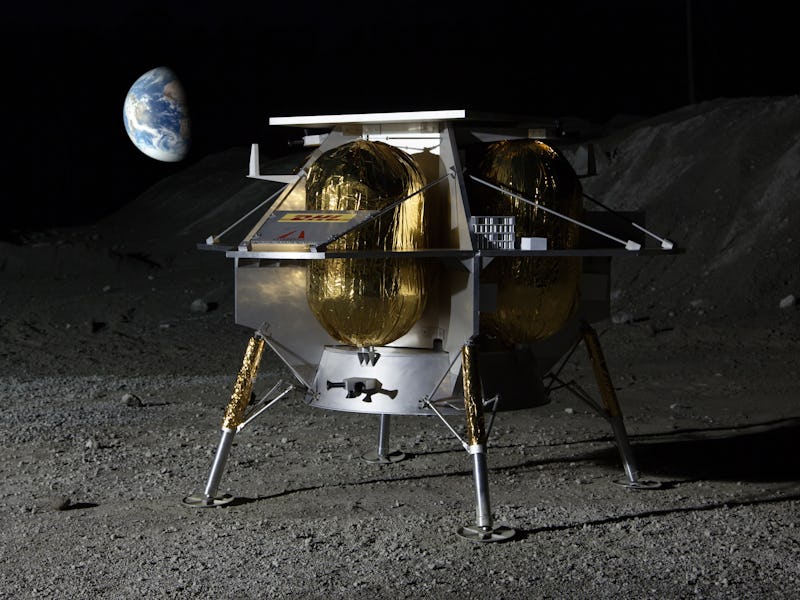Human Ashes Will Travel to the Moon in 2019
Spaceflight company Astrobotic unveils more detail about its first mission to the lunar surface.

We’re going back to the moon! Private spaceflight company Astrobotic announced this week that its Peregrine Lunar Lander will fly to the moon aboard a United Launch Alliance Atlas V rocket sometime in 2019, coinciding with the 50th anniversary of the Apollo 11 mission. On Monday, the company followed up with an animated video of how that mission will happen.
One of the many customers that have bought payload space on that mission is Elysium Space, which will use Peregrine for its “Lunar Memorial” service.
“Elysium is providing Lunar Memorial services to deliver a symbolic portion of remains to the surface of the Moon,” Carolyn Pace of Astrobotic tells Inverse. Essentially, Peregrine will be taking up a portion of human ashes sent to them from relatives of the deceased.
Here’s the video released by Astrobotic that imagines what its mission will look like:
Elysium Space says it specializes in “memorial spaceflight,” naming itself after the afterlife realm depicted in Greek mythology. “We are dedicated to offering awe-inspiring celestial services to the world and celebrate the significance of lives that have been lived with dignity and honor,” is the promise on the company website — first through a SpaceX Falcon 9 launch which will send ashes into Earth’s orbit, followed by the 2019 mission to the moon. The Shooting Star Memorial is $2,490 a person, while the Lunar Memorial is a hefty $9,950.
In 2007, Google launched the Lunar XPRIZE competition to encourage engineers to come up with a privately backed plan to send a robotic spacecraft to the moon. Under the competition, many groups have been angling to launch a spacecraft to the moon and land it on the lunar surface for a deadline that is now set before the end of this year.
Of the five finalists pursuing the XPRIZE, Astrobotic is not one of them. The company dropped out of the competition last December after it delayed launch for 2019. It’s a bummer to know we won’t be seeing Peregrine make it to the moon first, but that doesn’t really take away from what a wonderful achievement it would be to see Astrobotic and ULA facilitate a lunar landing on Apollo 11th’s 50th anniversary.
The Peregrine Lunar Lander mission will launch in 2019.
Peregrine is part of Astrobotic’s goal of creating a “Rust Belt” for the international community when it comes to traveling to the moon. On the inaugural 2019 mission, the lander will take 35 kilograms of customer payloads into space — including the ashes collected by Elysium Space — from 11 different countries.
Although this mission is primarily a demonstration to show NASA, international agencies, and private customers around the world that the Peregrine works, the 2019 mission will still serve as something of a business trip — hence the ashes. (It should be emphasized, those ashes, unlike other payloads, won’t be taken to the moon, but deposited in Earth orbit’s as the Peregrine makes its way farther into space.)
The rest of Peregrine’s payload “ranges from rovers, to scientific experiments, to marketing products,” says Pace. The Mexican Space Agency will use the launch to send its own instrument. “That will be the first Latin American experiment to go up to the moon,” she says. Astroscale, a Singapore-based company focused on orbital debris detection, is sending Lunar Dream Capsules: “messages from children all over the world,” says Pace.
With so much hype brewing about what humans have in store for the moon over the next few generations (space mining! moon bases! a stopping point to get to Mars!) Astrobotic may be developing something that will pay off wildly in the next few years.